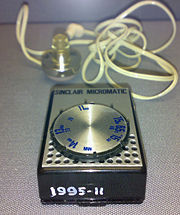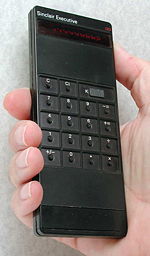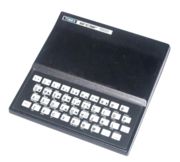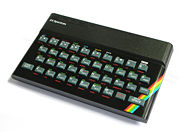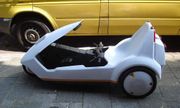Sinclair Research
2008/9 Schools Wikipedia Selection. Related subjects: Companies
| Sinclair Research Ltd | |
|---|---|
| |
|
| Type | Limited company |
| Founded | Cambridge, England (1961) |
| Headquarters | London, England |
| Key people | Sir Clive Sinclair, Founder Nigel Searle, Director (1973 to 1986) Jim Westwood Rick Dickinson, Designer |
| Industry | Computing Electronics Hi-fi equipment |
| Products | Sinclair Executive Sinclair Scientific Sinclair ZX Spectrum Sinclair QL |
| Revenue | £102 million GBP (1985) |
| Employees | 140 (1980s) 3 (1990) 1 (1997) |
| Website | Sinclair Research |
Sinclair Research Ltd is a consumer electronics company founded by Sir Clive Sinclair in Cambridge, England (originally as Sinclair Radionics in 1961) to sell hi-fi equipment, calculators, radios and other products. In 1966 Sinclair created but never sold the world's first pocket television. In 1972 Sinclair introduced Sinclair Executive, a calculator noted for its slim design. Many other pocket calculator variants followed including the Sinclair Cambridge, the Sinclair Scientific and the Sinclair Oxford.
In the 1980s Sinclair entered the personal computer market with the ZX80 at £99.95, at the time the cheapest personal computer for sale in the UK. In 1982 the ZX Spectrum was released, later becoming Britain's best selling computer, competing aggressively against Commodore and Amstrad. At the height of its success, and largely inspired by the Japanese Fifth Generation Computer programme, the company established the "MetaLab" research centre at Milton Hall (near Cambridge), in order to pursue Artificial Intelligence, Wafer Scale Integration, formal verification and other advanced projects. The combination of the 1984 failures of the Sinclair QL computer and TV80, and the 1985 Sinclair C5 electric vehicle bankrupted the company, and a year later Sinclair sold the rights to their computer products and brand name to Amstrad. Sinclair Research Ltd still exists today as a one man company, continuing to market Sir Clive Sinclair's newest inventions.
The first twenty years: 1961 to 1980
Sinclair Radionics
On 25 July 1961 Sir Clive Sinclair founded Sinclair Radionics in Cambridge, England after raising funds to start the business by writing articles for Practical Wireless magazine. Sinclair Radionics developed hi-fi products, radios, calculators and scientific instruments. In 1963 Sinclair Radionics introduced their first radio with the "Sinclair Slimline" in kit form at forty-nine shillings and sixpence. A year later in 1964 Sinclair released the "Micro-6", match-box size radio which the company claimed was the "world's smallest radio". It could also be worn on your wrist with the "Transrista". In 1965 the "Micro-FM" debuted as "the world"s first pocket-size FM tuner-receiver", but was unsuccessful due to technical difficulties. Despite problems, illegal clones were produced in the far-east. Sinclair's final 1960s radio kit was the 1967 "Micromatic", billed as "the world's smallest radio" like Sinclair's earlier radios. The "Micromatic" was a reasonable success and was sold until 1971. In May 1971 Sinclair Radionics made £85,000 profit on £563,000 turnover; the following year profit increased to £97,000 on turnover of £761,000.
In 1966 Sinclair Radionics entered the hi-fi market with the "Stereo 25", a low-cost pre-amp control system. Production was halted in 1968 due to low supply of transistors which had been purchased in 1964 as rejects from other manufacturers. In 1969 it was replaced by the "Stereo Sixty". This soon became Sinclair's most successful audio product, being the second product of the "Project 60" range. The "Project 60" products sold well and were supplemented by the "Project 605" kit in 1972. It was eventually superseded by the more advanced "Project 80" kit in 1974. In September 1973 Sinclair purchased "Ablesdeal" so that he would be able to avoid the delay of incorporating a company if it became convenient for him to shift his ambitions away from Sinclair Radionics. In May 1973 Sinclair Radionics generated £1.8m turnover.
In 1966 Sinclair Radionics developed the world's first portable television, the "Microvision", but never attempted to sell it because development costs would have been too high based on the complicated design the Microvision used. In 1976 it was sold as a revised version, the "Microvision TV1A/MON1A" at £99.95. Supply exceeded demand, and 12,000 units were left unsold until they were sold off cheaply. This resulted in a £480,000 loss for Sinclair. Sir Clive Sinclair was certain that the TV1B model released in 1978 would be more successful, but sales were disappointing. The technology was sold to Binatone.
During the majority of the 1970s Sinclair focused on building the most affordable pocket calculators with the best design. In 1972 Sinclair released the world's first slim-line pocket calculator, the Sinclair Executive, for £79.95. The calculator only included basic math functions, and the LED display required lots of power. It is often credited as being the world's first attractively-styled calculator that didn't require mains power to be used like prior calculators. The Executive was a phenomenal success, earning Sinclair £1.8m in profit. In 1973 the "Executive Memory" was introduced at a far cheaper price of £24.95. 1974 saw the release of the Sinclair Scientific, a scientific pocket calculator for the very competitive price of £49.95. It used RPN, and displayed in scientific format with a 5 digit mantissa and a 2 digit exponent. In 1977 a revised model, the "Scientific Programmable", was released at £29.95. The Scientific Programmable Mark 2 was later released, reducing the price to £17.22.
In 1975 Sinclair Radionics launched the £29.95 Oxford 300 scientific briefcase calculator. Sinclair attempted to capture the top-end calculator market with the Sinclair Sovereign, available in plated gold or silver. The calculator was critically acclaimed for its excellent engineering and design and enjoyed short success.
In August of 1975 Sinclair introduced the Black Watch at £17.95 in kit form and £24.95 ready-built. Including a 5-digit LED display, it suffered from technical flaws related with the battery and accuracy. The company began to see significant commercial losses because of the product. In August 1975 Sinclair changed the name of Ablesdeal to "Sinclair Instrument Ltd". Exactly a year later the National Enterprise Board bought a 43% stake in Sinclair Radionics for £650,000. Finding it inconvenient to share control of his company, Sinclair encouraged Chris Curry, who had been working for Radionics since 1966, to leave and get Sinclair Instrument started.
Sinclair Instrument developed the "Wrist Calculator" to generate cash, which soon became a commercial success selling in surprising figures. In July 1977 Sinclair Instrument Ltd was renamed to "Science of Cambridge Ltd". Around about the same time Ian Williamson showed Chris Curry a prototype computer based around a National Semiconductor SC/MP and some parts taken from an earlier Sinclair calculator. Curry was impressed and encouraged Sinclair to adopt this as a product; an agreement was reached with Williamson but no contract was ever signed. National Semiconductor had offered to redesign the project so that it used only their components and they also offered to manufacture the boards.
Science of Cambridge
In June 1978 Science of Cambridge launched a microcomputer kit, marketed as the MK14, based around the National SC/MP chip. By July 1978 a personal computer project was already underway. When Sinclair learnt that the NewBrain could not be sold at below the sub-£100 price that he envisaged, his thoughts turned to the ZX80 instead. In May 1979 Jim Westwood started the ZX80 project at Science of Cambridge, which was launched in February 1980 at £79.95 in kit form and £99.95 ready-built. In November of the same year Science of Cambridge was renamed to "Sinclair Computers Ltd".
Success and then decline: 1981 to 1986
Home computers
In March 1981 "Sinclair Computers" was renamed to "Sinclair Research Ltd" and the Sinclair ZX81 was launched at £49.95 in kit form and £69.95 ready-built, by mail order. In February 1982 Timex Corporation obtained a license to manufacture and market Sinclair's computers in the USA under the name Timex Sinclair. In April the ZX Spectrum was launched, priced at £125 for the 16 KiB RAM version and £175 for the 48 KiB version. In July Timex launched the TS 1000 (a version of the ZX81) in the US. In March 1982 Sinclair made an £8.55m profit on turnover of £27.17m, including £383,000 government grants for flat screen.
In 1982 Clive Sinclair converted the Barker & Wadsworth mineral water bottling factory at 25 Willis Road, Cambridge, into the company's new headquarters. It was sold to Cambridgeshire County Council in December 1985 due to Sinclair's finance troubles.
In January 1983 the ZX Spectrum personal computer was presented at the Las Vegas Consumer Electronics Show. In September the Sinclair TV80 television was launched, using flat-screen technology unlike Sinclair's previous CRT televisions. The TV80 was a commercial failure selling only 15,000 units and not covering its development costs of £4m.
In 1983 the company bought Milton Hall in the village of Milton, outside Cambridge, for £2m, establishing their MetaLab research and development facility there.
In late 1983 Timex decided to pull out of the "Timex Sinclair" venture, which had failed to break the US market as expected due to strong competition. However Timex computers continued to be produced for several years in other countries. Timex Portugal, with the TS 2048 and 2068, launched improved versions capable of displaying more colours and with a better circuit design. They also developed and launched the FDD 3000, a floppy disk system, that was not well received by the market.
The Sinclair QL was announced on January 12, 1984, shortly before the Apple Macintosh actually went on sale. This was a new computer to be aimed at the business market and costing £399. However, at this point the final design had not yet been completed. Shipping finally started in May, with 13,000 orders taken, but only a few hundred units delivered at first. Because the initially supplied ROM had proved insufficient, early machines were shipped with a "kludge" or "dongle" hanging out of the machine containing an additional ROM chip. Your Sinclair noted that it was "difficult to find a good word for Sinclair Research in the computer press".
Fully working QLs were not available until late summer; complaints against Sinclair regarding delays were upheld by the Advertising Standards Authority in May of the year (in 1982 it had upheld complaints about delays in shipping Spectrums). Especially severe were allegations that it was cashing cheques months before machines were shipped. The QL was nowhere near as successful as Sinclair's earlier computers. In the autumn Sinclair were still publicly predicting it would be a "million seller", with 250,000 sold by the end of the year . QL production was suspended in February 1985, and the price was halved by the end of the year .
Between 1981 and 1988 Sinclair created ten peripherals for their computers including joysticks, a spark printer and memory expansion modules. Some of the peripherals were developed by other companies but still marketed under the Sinclair brand. External storage for the Spectrum was usually on cassette tapes, as was common in the era. Rather than an optional floppy disk drive, Sinclair instead opted to offer their own system, the ZX Microdrive, a tape-loop cartridge system that was rather unreliable. This was also the primary storage device for the QL.
The ZX Spectrum+, a retooled ZX Spectrum with a new keyboard, was launched in October and appeared on WHSmith's shelves the day after release. Retailers stocked the machine in large numbers in expectation of good Christmas sales. However the machine did not sell in the numbers expected and, because retailers still had unsold stock, Sinclair's income from orders dipped alarmingly in January. The Spectrum+ had the same technical specifications as the original Spectrum. An upgraded Spectrum, the ZX Spectrum 128, was launched in Spain in September 1985 by the Spanish firm Investronica. January 1986 saw the machine launched in the UK, apparently in an attempt to generate cash.
|
|||||||||||||||||||||||||||||||||||||||||||||||||||||||||||||||||||||||||
Trouble and Amstrad acquisition
In January 1985 Sinclair released the "FM Wristwatch Radio", an LCD wristwatch with a radio attached. The aerial was built into the strap and the battery was hidden in the clasp, presumably in an attempt to balance out the considerable weight of the watch. The watch had several usage problems and never went into full production, making it one of the rarest Sinclair products.
Sir Clive had long held an interest in electric vehicles and during the early 1980s worked on the design of a single-seater "personal vehicle". A new company, Sinclair Vehicles Ltd, was formed in March 1983 (allowing Sinclair Research to concentrate on electronics) and its Sinclair C5 electric vehicle was launched on 10 January 1985. The battery powered vehicle aimed to solve environmental problems and be the first truly affordable vehicle at £399. It was a commercial disaster, selling only 17,000 units and losing Sinclair £7m, Sinclair Vehicles going into liquidation later the same year. The C5, combined with the failures of the QL and the TV80, caused investors to lose confidence in Sir Clive.
On 28 May 1985, Sinclair had announced that it wanted to raise an extra £10m to £15m to restructure Sinclair Research. Given the loss of confidence in the company, this proved hard to find. On 7 April 1986 the company sold its entire computer product range and the "Sinclair" brand name to Amstrad. This deal did not involve the company, merely its name and products.
Sinclair Research was reduced to an R&D business and holding company, with shareholdings in several new "spin-off" companies, formed to exploit technologies developed by the company. These included Anamartic Ltd. ( wafer-scale integration), Shaye Communications Ltd. ( CT2 mobile telephony) and Cambridge Computer Ltd. ( Z88 portable computer and satellite TV receivers).
The tireless inventor: 1990s to present
Today the company still exists but in a completely different form than it did in the 1980s. In 1993, 1994 and 1995 Sinclair made continuing losses on decreasing turnover, and began to worry investors since Clive Sinclair himself was using his own personal wealth to fund his inventions. By 1990 Sinclair's entire staff had been reduced to Sinclair himself, a salesperson/administrator, and an R&D employee. By 1997 reportedly only Sinclair on his own was working at his company.
In 1992 the " Zike" electric bicycle was released, Sinclair's second attempt at changing means of transportation. The "Zike" was a commercial failure much like the C5 was, and only sold a total of 2,000 units. It had a maximum speed of 10 mph (16 km/h), and was only available through mail order.
In 2003 the Sinclair "ZA20 Wheelchair Drive Unit" was introduced, designed and manufactured in conjunction with Hong Kong's Daka Designs, a partnership which also led to the SeaDoo Sea Scooter underwater propulsion unit. In 1999 Sinclair released the world's smallest radio with the "Z1 Micro AM Radio".
On July 12, 2006, the A-bike, a folding bicycle invented by Sir Clive Sinclair, was released and went on sale for £200. It had been originally announced two years previously, in 2004.
Cancelled projects
The following computer products were under development at Sinclair Research during the 1980s but never reached production:
- LC3: standing for "Low Cost Colour Computer", the LC3, developed during 1983 by Martin Brennan, was intended to be a cheap Z80-based games console implemented in two chips, using ROM and (non-volatile) RAM cartridges for storage. A multi-tasking OS for the LC3 with a full windowing GUI was designed by Steve Berry. It was cancelled in November 1983 in favour of the QL.
- SuperSpectrum: intended to be a 68008-based home computer, with built-in ZX Microdrive, joystick, RS-232 and ZX Net ports. Sinclair's SuperBASIC programming language was originally intended for this model but was later adopted for the QL. SuperSpectrum was cancelled in 1982 after the specification of the ZX83 (QL) had converged with it. (Not to be confused with Loki, which was described as the "SuperSpectrum" in an article in the June 1986 issue of Sinclair User magazine)
- Pandora: this was to be a portable computer with an integral flat-screen CRT display. Initially to be ZX Spectrum-compatible with a faster Z80 CPU, a built-in ZX Microdrive and a new 512×192-pixel monochrome video mode. Due to the limited size of flat CRT that could be manufactured, a series of folding lenses and mirrors were necessary to magnify the screen image to a usable size. The project was cancelled after the Amstrad take-over; however, the Pandora concept eventually transformed into the Cambridge Computer Z88.
- Loki: this project was an enhanced ZX Spectrum intended to rival the Commodore Amiga. Loki was to have a 7 MHz Z80H CPU, 128 KiB of RAM and two custom chips providing much enhanced graphics and audio capabilities. After the Amstrad buy-out in 1986, two engineers who had worked on the project, John Mathieson and Martin Brennan, founded Flare Technology to continue their work.
- Bob/Florin: according to Rupert Goodwins, this was a project to produce an add-on floppy disk drive for the ZX Spectrum.
- Tyche: this codename was assigned to a QL follow-on project running from 1984 to 1986. Among the features associated with Tyche were increased RAM capacity, internal floppy disk drives, the Psion Xchange application suite on ROM, and possibly the GEM GUI.
- Janus:: this name has been associated with a design concept for a "Super QL" based on wafer-scale integration technology.
- Proteus: this was rumoured to be a hypothetical portable version of the QL similar to Pandora.
